October 2024
North America News
On 27 September 2024, Senate Bill No. 1266 (Chapter 790) was signed by California’s governor to strengthen the restriction of Bisphenols in specific juvenile products such as juvenile feeding products and juvenile sucking and teething products.
The governor of the state of California signed Senate Bill No. 1266 (Chapter 790), for Product Safety: Bisphenol. This bill aims to amend the original requirement of Bisphenol restrictions as stated in California Health and Safety Code Section 108940, by:
Specifying the product scope
Extending the coverage for the restriction of Bisphenols’ species from Bisphenol A only, to ALL BISHENOL species
Key points of this amendment are summarized below.
Implementation Date
Effective from: 1 January 2026
Scope of Regulation
Applies to:
Juvenile feeding products
Juvenile sucking or teething products
Comparison Against Existing Bisphenols’ Requirement (differences are shown in RED)
| Original requirement | Revised requirement as per Senate Bill No. 1266 | |
| Chemical species covered | Bisphenol A only | All Bisphenols |
| Scope | - Bottle or cup designed or intended to be filled with any liquid, food, or beverage intended primarily for consumption from that bottle or cup by children. | - Juvenile feeding products - Juvenile sucking and teething products |
| Age grading for restricted product | ≤ 3 years of age | < 12 years of age |
| Requirement | ≤ 0.01 ppb | ≤ Practical Quantitation Limit (PQL)* |
Remark:
* PQL will be determined by the California Department of Toxic Substances Control when developing the corresponding test standard.
Bill AB 347 (Chapter 932) related to PFAS bans and labeling requirements would require the California Department of Toxic Substances Control (DTSC), on or before 01 January 2029, to adopt regulations for the enforcement of those prohibitions on the use of PFAS, and, on and after 01 July 2030, to enforce and ensure compliance with those provisions and regulations, as provided.
AB 347 (Chapter 932) Household product safety: toxic substances: testing and enforcement was recently signed into law by the Governor of California. The new law replaces Chapter 3 (commencing with Section 108075) to Part 3 of Division 104 of the Health and Safety Code (HSC) and applies enforcement mechanisms for existing and future per- and polyfluoroalkyl substances (PFAS) bans and labeling requirements.
The main contents are:
1. “Covered product” means any of the following:
Textile articles, as defined in PFAS related Bill AB 1817 (Section 108970).
Food packaging, as defined in PFAS related Bill AB 1200 (Section 109000).
A juvenile product, as defined in PFAS related Bill AB 652 (Section 108945).
Further interpretation of “Juvenile product”:
☑ “Juvenile product” means the following products designed for use by infants and children under 12 years of age: a baby or toddler foam pillow, bassinet, bedside sleeper, booster seat, changing pad, child restraint system for use in motor vehicles and aircraft, co-sleeper, crib mattress, floor playmat, highchair, highchair pad, infant bouncer, infant carrier, infant seat, infant sleep positioner, infant swing, infant travel bed, infant walker, nap cot, nursing pad, nursing pillow, playmat, playpen, play yard, polyurethane foam mat, pad, or pillow, portable foam nap mat, portable infant sleeper, portable hook-on chair, soft-sided portable crib, stroller, and toddler mattress.
☒ “Juvenile product” as referenced does not mean (include) any of the following:A children’s electronic product, including, but not limited to, a personal computer, audio and video equipment, calculator, wireless phone, game console, handheld device incorporating a video screen, or any associated peripheral such as a mouse, keyboard, power supply unit, or power cord.
A medical device
An internal component of a juvenile product that would not come into direct contact with a child’s skin or mouth during reasonably foreseeable use and abuse of the product.
An adult mattress
2. PFAS restriction:
Prohibit if intentionally added.
PFAS level should not exceed 100 ppm (as measured in total organic fluorine).
3. Registration and Testing:
Dates to adopt regulations for the enforcement of those prohibitions on the use of PFAS and, subsequently, to enforce and ensure compliance with those provided provisions and regulations are as follows:
Department of Toxic Substances Control (DTSC) shall adopt regulations to implement the PFAS restrictions,
publish/update testing methods and third-party accreditations.
(on or before 01 January 2029)
Manufacturers should register with DTSC by specified manner.
(On or before 01 July 2029)
The department (DTSC) shall enforce and ensure compliance with this chapter.
(On and after 01 July 2030)
On 09 September 2024, the CPSC published a notice of proposed rulemaking to revise 16 CFR 1250, the safety standard for toys. The proposed rule outlines additional performance and labeling requirements for water bead toys and toys that contain water beads (https://www.federalregister.gov/documents/2024/09/09/2024-19286/safety-standard-for-toys-requirements-for-water-beads).
The US Consumer Product Safety Commission (CPSC) has published a notice of proposed rulemaking (NPR) related to water beads. The intent is to revise the existing consumer product safety rule for toys, 16 CFR 1250.
The NPR, which was published on 09 September 2024, proposes to add performance and labeling requirements for water bead toys and toys that contain water beads in an effort to address the following four identified hazards specific to the water beads themselves:
Ingestion
Insertion into the nose or ear
Aspiration
Choking
A water bead is defined by the NPR as a “various shaped water absorbent polymer, such as, but not limited to, polyacrylamide and polyacrylate, which expands when soaked in water.”
The Standard Consumer Safety Specification for Toy Safety, ASTM F963-23, includes requirements for expanding materials. However, according to the CPSC, after assessing the current ASTM requirements for this category of toys, the requirements were determined to be insufficient in addressing these known water bead hazards.
The proposed rule would add the following to 16 CFR 1250:
Performance requirements to address ingestion, choking, aspiration and insertion hazards:
Water beads as received or water beads removed from a toy, which fit entirely inside the small parts cylinder in their pre-expanded state, shall not expand more than 50 percent in any dimension and shall remain whole while also completely passing through the new proposed funnel test gauge under its own weight after expansion.
Acrylamide limits and testing:
Water beads shall not have more than 65 µg acrylamide extractable from 100 small water beads (defined as <4 mm across the smallest diameter of the bead prior to hydration) or from one large water bead (defined as ≥4 mm across the smallest diameter of the bead prior to hydration).
Marking, labeling and instructional literature requirements:
Packaging and container marking and labeling shall be established to include on-product warnings that address the following three elements:
A description of the hazard;
Information about the consequences of exposure to the hazard; and
Instructions regarding appropriate hazard-avoidance behaviors.
16 CFR 1112, Requirements Pertaining to Third Party Conformity Assessment Bodies, is also proposed to be updated to include water beads in the CPSC’s list of notice of requirements (NORs) for which third party testing is required.
The CPSC is proposing an effective date of 90 days after the final rule is published in the Federal Register. Interested parties are invited to submit their comments by 08 November 2024.
In the US, when hazards are identified in consumer products, they will be recalled and published in the Consumer Product Safety Commission (CPSC) Recent Recalls on the CPSC website, which is updated daily. The US recalls from 01 September 2024 to 30 September 2024 are summarized below:
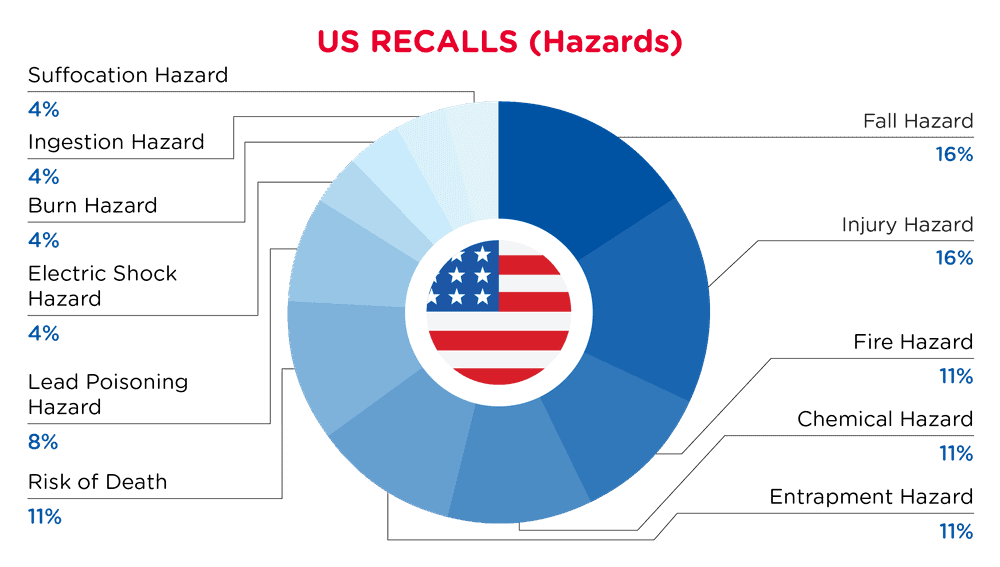
| Hazards | Frequency |
| Fall Hazard | 4 |
| Injury Hazard | 4 |
| Fire Hazard | 3 |
| Chemical Hazard | 3 |
| Entrapment Hazard | 3 |
| Risk of Death | 3 |
| Lead Poisoning Hazard | 2 |
| Electric Shock Hazard | 1 |
| Burn Hazard | 1 |
| Ingestion Hazard | 1 |
| Suffocation Hazard | 1 |

| Product Categories | Frequency |
| Sporting Goods / Equipment | 5 |
| Machinery | 4 |
| Toys and Childcare Products | 3 |
| Furniture | 2 |
| Electrical Appliances | 2 |
| Chemicals | 2 |
| Home Electrical Appliances | 1 |
| Tools and Hardware | 1 |
| Outdoor Living Items | 1 |
| Pharmacy | 1 |
| Jewelry | 1 |
For a complete list click here
In Canada, when hazards are identified in consumer products, they will be recalled and published in the Recalls and Safety Alerts Database on the Health Canada website, which is updated daily. The Canada recalls from 01 September 2024 to 30 September 2024 are summarized below:
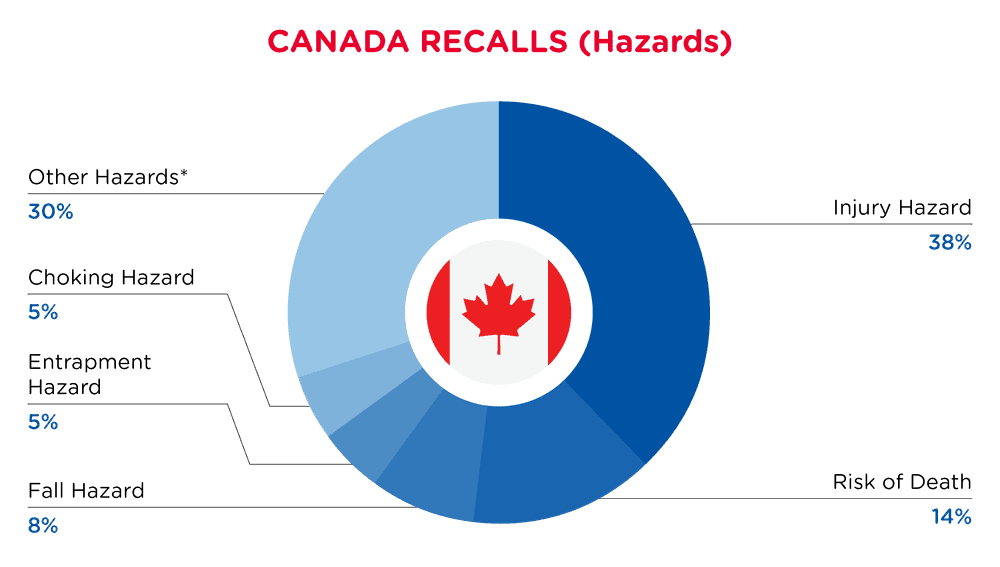
| Hazards | Frequency |
| Injury Hazard | 14 |
| Risk of Death | 5 |
| Fall Hazard | 3 |
| Entrapment Hazard | 2 |
| Choking Hazard | 2 |
| Other Hazards* | 11 |
*Other Hazards include Burn Hazard, Chemical Hazard, Crash Hazard, Damage to Skin, Electric Shock Hazard, Fire Hazard, Ingestion Hazard, Lead Poisoning Hazard, Microbiological Hazard, Suffocation Hazard and Tip-Over Hazard with a frequency of less than 2.

| Product Categories | Frequency |
| Chemicals | 7 |
| Toys and Childcare Products | 4 |
| Tools and Hardware | 3 |
| Electrical Appliances | 3 |
| Fabric / Textile / Garment / Home Textile | 1 |
| Home Electrical Appliances | 1 |
| Protective Equipment | 1 |
| Furniture | 1 |
For a complete list click here
Europe News
In March 2024, ECHA announced a consultation phase for triphenyl phosphate as SVHC, but this was postponed by ECHA in June 2024. Following this suspension period, on 16 October 2024, ECHA announced this chemical will be included a member of SVHC candidate list in November 2024.
On 01 March 2024, the European Chemical Agency (ECHA) launched a 45-days public consultation on triphenyl phosphate (CAS number: 115-86-6)], as a potential Substance of Very High Concern (SVHC).
During the consultation period, ECHA received substantial new information for Triphenyl phosphate which had recently become available. To ensure the new information provided for this chemical would be properly evaluated and considered in the SVHC identification process, ECHA suspended the inclusion of this chemical into the SVHC candidate list temporarily, in June 2024.
However, after the discussion during October’s Member State Committee (MSC) meeting, ECHA announced that triphenyl phosphate will be identified as a member of the SVHC candidate list on 16 October 2024, because of its endocrine disrupting properties.
Officially, ECHA will add the substance to the Candidate List in early November 2024.
The number of SVHCs on the Candidate List will be updated to 242 entries at that time.
Details of the new SVHC candidate list’s member, triphenyl phosphate, are summarized below.
| Substance name | EC number | CAS number | Reason for inclusion | Potential usage |
|---|---|---|---|---|
| Triphenyl phosphate | 204-112-2 | 115-86-6 | Endocrine disrupting properties [Article 57(f) – environment] | Cosmetics Production of plastic and rubber products Adhesives and sealants |
Manufacturers and importers should take note of triphenyl phosphate and the current use of this chemical compound in their processes or products to plan accordingly.
On 27 September 2024, Regulation (EU) 2024/2555 was issued by the European Commission to amend the requirement of Hexabromocyclododecane (HBCDD) under the EU Persistent Organic Pollutants (POPs) Regulation - Regulation (EU) 2019/1021.
The European Commission issued Regulation (EU) 2024/2555, the Recast Regulation for Persistent Organic Pollutants (POPs), on 27 September 2024. This regulation is an amendment which aims to update and strengthen the EU POPs Regulation - Regulation (EU) 2019/1021, by adjusting the permissible limits of Hexabromocyclododecane (HBCDD), addressing ongoing concerns about its presence in recycled materials.
Key points of the amendment are summarized as below.
Implementation Date
Effective from: 20 days after publication (17 October 2024)
Scope of Regulation
Applies to:
Manufacturing, placing on the market, and use of substances, mixtures, and articles containing HBCDD and its main diastereoisomers.
Comparison for HBCDD requirement (differences are shown in RED)
| Original requirement | Revised requirement as per Regulation (EU) 2024/2555 | |
| Chemical species covered | Hexabromocyclododecane (HBCDD) and its main diastereoisomers α-HBCDD β-HBCDD γ-HBCDD | Hexabromocyclododecane (HBCDD) and its main diastereoisomers α-HBCDD β-HBCDD γ-HBCDD |
| Specific exemption on intermediate use or other specification for HBCDD* (Permissible Limit for HBCDD) | ≤ 100 mg/kg (0.01 % by weight) where it is present in substances, mixtures, articles or as constituents of the flame-retarded articles | ≤ 75 mg/kg (0.0075 % by weight) where it is present in substances, mixtures, articles or as constituents of the flame-retarded articles. ≤ 100 mg/kg (0.01 % by weight) for the use of recycled polystyrene in the production of EPS and XPS insulation material for use in buildings or civil engineering works |
Remark:
The exemptions shall be reviewed and assessed by the Commission by 1 January 2026.
The German Federal Institute for Risk Assessment recently updated recommendations for rubber in contact with food, including natural and synthetic rubber (BfR XXI/1) and special consumer goods made of natural and synthetic rubber (BfR XXI/2). These updated documents can be applied immediately.
On 01 September 2024, the German Federal Institute for Risk Assessment (BfR) updated its recommendation for rubber in contact with food. This is inclusive of natural and synthetic rubber (BfR XXI/1) and special consumer goods made from natural and synthetic rubber (BfR XXI/2).
Following are the updated recommendations from the guidelines (Table 1):
Table 1:
| # | |
| BfR XXI | Commodities based on natural and synthetic rubber |
| BfR XXI/1 | Natural and synthetic rubber in contact with food |
| BfR XXI/2 | Special consumer goods made of natural and synthetic rubber and of latexes made of natural and synthetic rubber (formerly special category) |
Notes:
a for silicone rubber, Recommendation XV "Silicones" applies.
b in preparation: BfR XXI/3 Consumer goods made of cross-linked thermoplastic elastomers.
c Thermoplastic elastomers (TPE) produced from the monomers and additives listed in the Plastics Regulation (EU) No 10/2011 will fall within the scope of the Regulation and will be the subject of the upcoming Recommendation BfR XXI/3.
The main changes and requirements are:
1. For BfR XXI:
BfR XXI is the frame regulation of rubber and mainly relates to definitions, explanatory notes, evaluated chemical substances and related restrictions.
For the inclusion of substances from Table 2 (not evaluated) in BfR XXI/1 and BfR XXI/2 to evaluated substances in BfR XXI, an application must be submitted to the BfR.
30 September 2027 will be set as the new deadline within which applications for the previously notified substances can be submitted.
For BfR XXI/1 and BfR XXI/2:
Comparison of restrictions, (differences identified in RED in Table 2):
Table 2:
| Recommendation | Testing item | Previous requirement | New requirement |
|---|---|---|---|
| BfR XXI/1 Natural and synthetic rubber in contact with food (including SBR, NBR, EPDM, TPV, etc.) | Overall migration | 10 mg/dm2 | Generally, the limit is 10 mg/dm2. For caps, seals, stoppers and similar closures as well as membranes, a value of 60 mg/dm² applies. For latex disposable gloves, a value of 30 mg/dm² applies when tested in 3 % acetic acid, of which a maximum of 10 mg/dm² is organic content. |
| Migration of N-Nitrosamines | Not be detectable (1 μg/dm²) | Not be detectable (1 μg/dm²) | |
| Migration of primary aromatic amines (PAA) | Not be detectable (the detection limit is 0.002 mg/l individually and 0.01 mg/l in total) | Not be detectable (the detection limit is 0.002 mg/l individually and 0.01 mg/l in total) | |
| Migration of zinc, aluminum and lead | Zn: 25 mg/kg Al: 1 mg/kg Lead: not detectable (0.01 mg/kg) | Zn: 25 mg/kg Al: 1 mg/kg Lead: not detectable (0.01 mg/kg) | |
| Migration of formaldehyde | 6 mg/kg | ||
| Migration of secondary aliphatic and cycloaliphatic amines | 5 mg/dm2 | ||
| BfR XXI/2 Special consumer goods made of natural and synthetic rubber | Overall migration | 60 mg/kg | 60 mg/kg |
| Release of N-Nitrosamines and Nitrosable substances (saliva simulation) | N-Nitrosamines: not detectable (10 μg/kg). Nitrosable substances: (0.1 mg/kg). | N-Nitrosamines: not detectable (10 μg/kg). Nitrosable substances: (0.1 mg/kg). | |
| Migration of primary aromatic amines (PAA) | Not be detectable (the detection limit is 0.002 mg/l individually and 0.01 mg/l in total) | Not be detectable (the detection limit is 0.002 mg/l individually and 0.01 mg/l in total) | |
| Migration of zinc, aluminum and lead (3% acetic acid) | Zn: 25 mg/kg Al: 1 mg/kg Lead: not detectable (0.01 mg/kg) | Zn: 25 mg/kg Al: 1 mg/kg Lead: not detectable (0.01 mg/kg) | |
| Migration of formaldehyde (3% acetic acid) | 3 mg/L | 6 mg/kg |
Manufacturers, importers and distributors of such commodities should take note of the updated recommendations. The updated documents can be applied immediately.
In Europe, when Hazards are identified in non-food consumer products, the products will be recalled and published in the Safety Gate system, which is updated weekly. The European recalls from 01 September 2024 to 30 September 2024 are summarized below:
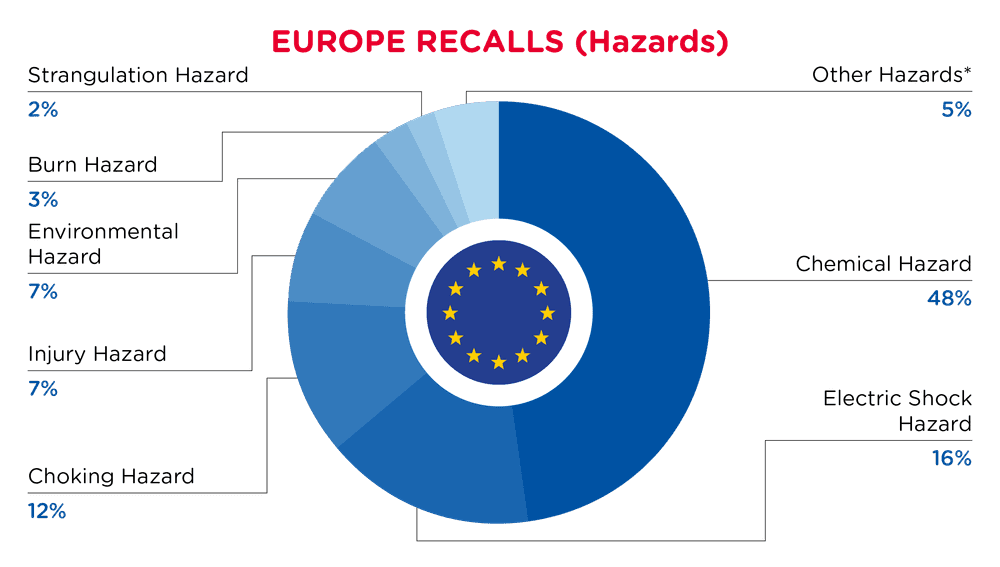
| Hazards | Frequency |
| Chemical Hazard | 129 |
| Electric Shock Hazard | 44 |
| Choking Hazard | 33 |
| Injury Hazard | 18 |
| Environmental Hazard | 18 |
| Burn Hazard | 9 |
| Strangulation Hazard | 6 |
| Other Hazards* | 12 |
*Other Hazards include Fire Hazard, Microbiological Hazard, Damage to Hearing, Health Risk Hazard, Suffocation Hazard, Damage to Sight, Entrapment Hazard and Drowning Hazard with a frequency of less than 5.

| Product Categories | Frequency |
| Toys and Childcare Products | 78 |
| Electrical Appliances | 47 |
| Bodycare / Cosmetics | 44 |
| Fabric / Textile / Garment / Home Textile | 20 |
| Chemicals | 11 |
| Jewelry | 7 |
| Home Electrical Appliances | 5 |
| Sporting Goods / Equipment | 5 |
| Footwear | 5 |
| Other Categories* | 23 |
*Other Categories include Computer / Audio / Video / Other Electronics & Accessories, Outdoor Living Items, Furniture, Tools and Hardware, Household Items, Protective Equipment, Car Accessories, Machinery, Food Contact Material and Accessories with a frequency of less than 5.
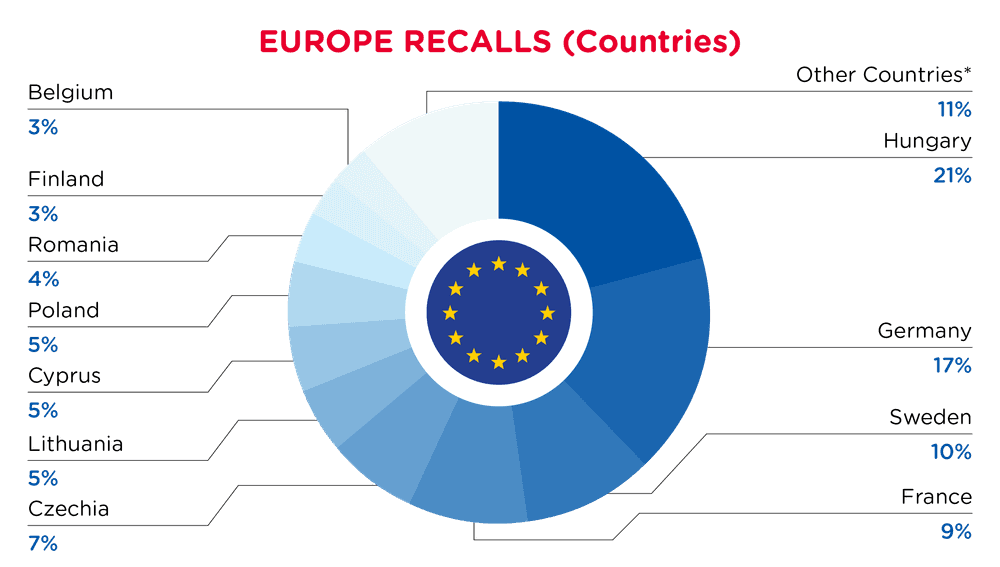
| Notifying Country | Frequency |
| Hungary | 51 |
| Germany | 42 |
| Sweden | 25 |
| France | 21 |
| Czechia | 17 |
| Lithuania | 13 |
| Cyprus | 12 |
| Poland | 11 |
| Romania | 10 |
| Finland | 8 |
| Belgium | 8 |
| Other Countries* | 27 |
*Other Countries include Norway, Malta, Ireland, The Netherlands, Bulgaria, Spain, Croatia, Luxembourg, Greece, Denmark and Slovakia with a frequency of less than 7.
For a complete list click here
Asia News
On 10 September 2024, Japan has put forward amendments to the general tests and specifications for apparatus, containers, and packaging (ACP) used in food contact applications, categorized by material type for ACP or their raw materials, under Article 18, Paragraph (1) of the Food Sanitation Act (Act No. 233 of 1947). The proposed revisions are expected to be enforced within the 2025 calendar year.
Japan has proposed revisions to general tests and specifications for apparatus, containers and packaging (ACP) for food contact by material type for ACP or their raw materials under Article 18, Paragraph (1) of the Food Sanitation Act (Act No. 233 of 1947). These amendments were put forth on 10 September 2024.
The proposed revisions, as outlined, concern the following:
1. General tests for ACP:
Delete test methods:
Xylene Solubility Substance Test
Strength Test
Heavy Metals Limit Test (Material Test)
Arsenic Limit Test (Material Test)
n-Hexane Extract Test
Establish an overall migration test that measures the total amount of substances migrating from a sample into a food simulant
Modify the “Preparation Methods for the Test Solutions for Migration Tests”
2. Reagents and test solutions:
Delete certain reagents, solutions and other reference materials that are no longer required to be specified.
3. Specifications by material type for ACP or their raw materials:
Transfer test methods that are specified in D to B.
Set specifications for the overall migration.
4. Specifications by application for ACP:
Delete the specifications for the strength tests that are specified in (3) ~ (5) of 1 “Containers and Packaging Used for Food That Are Packed in Containers/Packaging and Sterilized by Autoclaving and Heating (Excluding canned foods or bottled foods).”
Delete the specifications that are specified in 2 “Containers and Packaging Used for Soft Drinks (Excluding Fruit Juice as Raw Materials).”
Delete the specifications for the materials that are specified in item 8 “Cups Used When Selling the Relevant Products” of (2) “Cup Vending Machines to Sell Pasteurized Fermented Milk Drinks” of 3 “Specifications for Apparatus used for Milk. Etc. (Referring to Milk and Milk Products as Well as Foods Using These as Principal Ingredients).”
Delete specifications that are specified in 4 “Specifications for Containers and Packaging used for Milk, Etc. or the Raw Materials Thereof, and Standards for the Manufacturing Methods Thereof.”
Delete the specifications for the materials that are specified in (3) “Containers” of 6 “Food Vending Machines (Limited to Those Having Structures for Which the Parts of the Machine Come into Direct Contact With Foods) and Containers Used to Sell the Food Through These Vending Machines.”
Delete the specifications that are specified in (2) “Synthetic-resin ACP” of 7 “Specifications for Apparatus or Containers and Packaging to Carry Undiluted Liquids of Soft Drinks in Cup Vending Machines or Fully Automatic Preparation Machines.”
The revisions would be enforced during 2025.
China News
In China, when hazards are identified in consumer products, they will be recalled and published in the SAMR Defective Product Administrative Centre, which is updated daily. The China recalls from 01 September 2024 to 30 September 2024are summarized below:
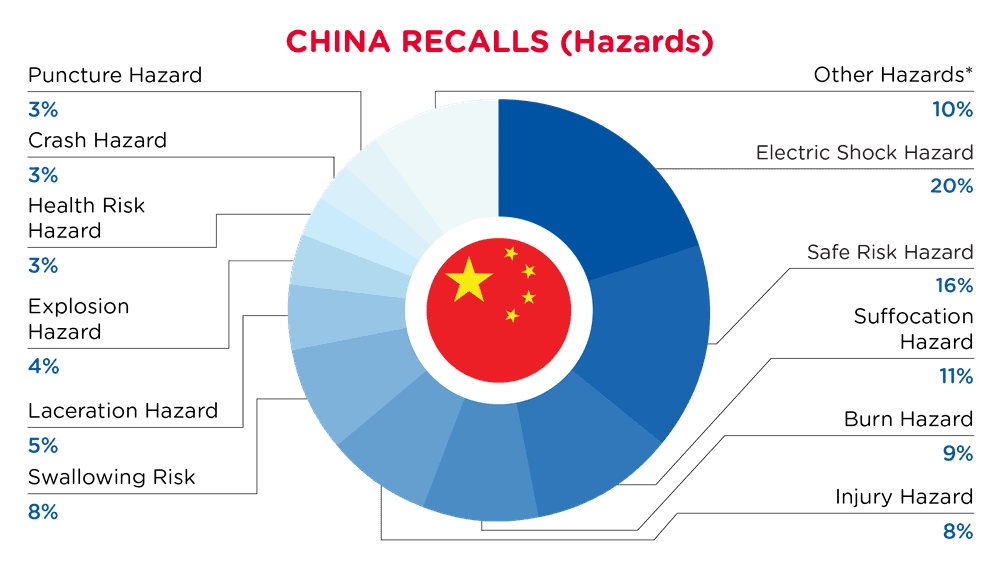
| Hazards | Frequency |
| Electric Shock Hazard | 18 |
| Safety Risk Hazard | 15 |
| Suffocation Hazard | 10 |
| Burn Hazard | 8 |
| Injury Hazard | 7 |
| Swallowing Risk | 7 |
| Laceration Hazard | 5 |
| Explosion Hazard | 4 |
| Health Risk Hazard | 3 |
| Crash Hazard | 3 |
| Puncture Hazard | 3 |
| Other Hazards* | 9 |
*Other Hazards include Chemical Hazard, Entrapment Hazard, Entanglement Hazard, Damage to Sight, Choking Hazard, Fall Hazard and Skin Irritation Risk with a frequency of less than 3.

| Product Categories | Frequency |
| Toys and Childcare Products | 21 |
| Sporting Goods / Equipment | 19 |
| Electrical Appliances | 13 |
| Food Contact Material | 10 |
| Home Electrical Appliances | 7 |
| Protective Equipment | 5 |
| Fabric / Textile / Garment / Home Textile | 4 |
| Stationery | 3 |
| Other Categories* | 4 |
*Other Categories include Tools and Hardware, Footwear and Household Items with a frequency of less than 3.
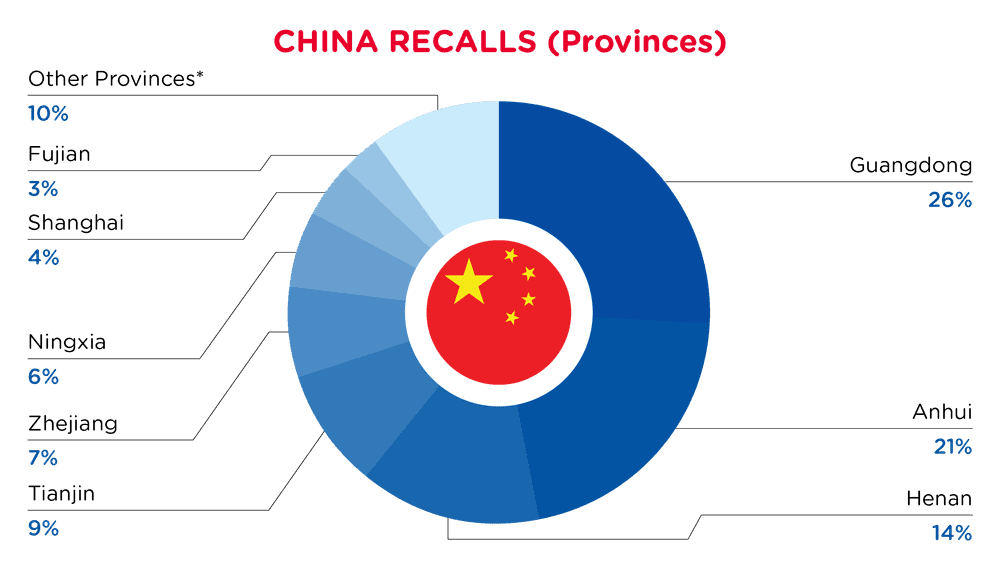
| Provinces | Frequency |
| Guangdong | 22 |
| Anhui | 18 |
| Henan | 12 |
| Tianjin | 8 |
| Zhejiang | 6 |
| Ningxia | 5 |
| Shanghai | 3 |
| Fujian | 3 |
| Other Provinces* | 9 |
*Other Provinces include Hubei, Hunan, Shandong, Chongqing, Gansu and Jiangsu with a frequency of less than 3.
For a complete list click here
Australia/New Zealand News
In Australia, when hazards are identified in consumer products, they will be recalled and published in the Recalls and Safety Alerts Database on the Australian Competition & Consumer Commission website, which is updated daily. The Australia recalls from 01 September 2024 to 30 September 2024 are summarized below:
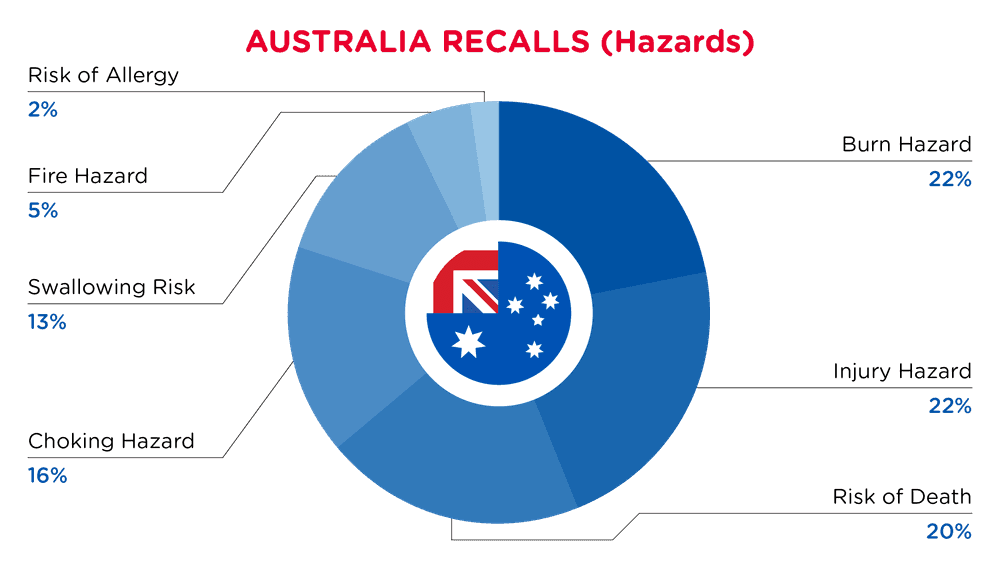
| Hazards | Frequency |
| Burn Hazard | 10 |
| Injury Hazard | 10 |
| Risk of Death | 9 |
| Choking Hazard | 7 |
| Swallowing Risk | 6 |
| Fire Hazard | 2 |
| Risk of Allergy | 1 |

| Product Categories | Frequency |
| Electrical Appliances | 4 |
| Home Electrical Appliances | 2 |
| Car Accessories | 1 |
| Toys and Childcare Products | 1 |
| Computer / Audio / Video / Other Electronics & Accessories | 1 |
| Fabric / Textile / Garment / Home Textile | 1 |
| Bodycare / Cosmetics | 1 |
| Sporting Goods / Equipment | 1 |
| Furniture | 1 |
For a complete list click here
Subscribe to our Regulatory Updates
Unsubscribe at any time. Read our privacy policy.